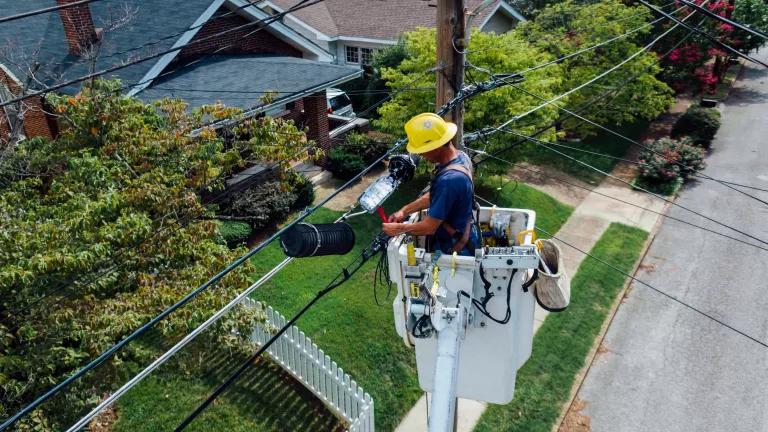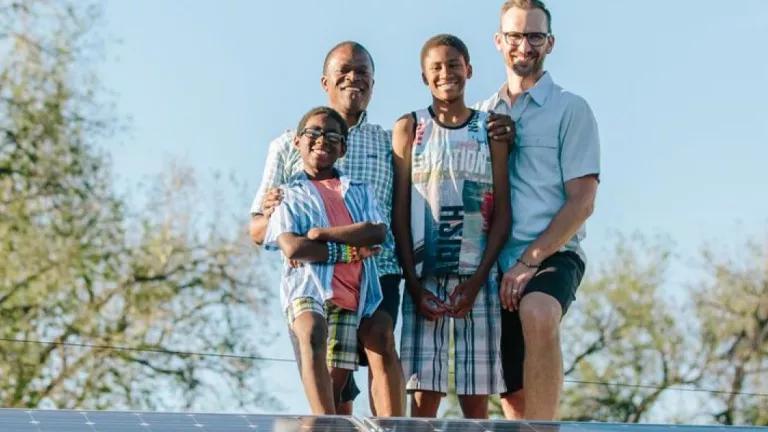Congress Must Advance a Bold Climate Innovation Budget
The Department of Energy is the largest public funder of clean energy research and development and houses critical efforts to support states and cities and deploy clean energy and energy efficiency.

The U.S. House panel that oversees the annual budget process for the Department of Energy (DOE) is diving into its plans for climate and clean energy innovation funding in a hearing today. The agency is the nation's largest public funder of clean energy research and development, and in the coming months, the congressional panel will write the bill that provides funding for DOE’s programs, with detailed direction for each technology office. We hope today’s testimonies will spark bold increases in Fiscal Year 2022 funding to match the scale of the crises we face.
DOE will be central to a federal strategy to combat the climate crisis. President Biden committed to investing $2 trillion in federal funding over his first term to address the climate crisis and $400 billion over 10 years to drive clean energy innovation. Following through on these investments, a substantial portion of which would likely flow through DOE, will create good jobs, cut pollution, and make progress on combating the climate crisis.
Unfortunately, DOE’s innovation programs are oversubscribed and, with current funding levels, are missing out on the opportunity to support many additional qualified companies, researchers, and organizations that can help us in reducing carbon emissions while creating jobs. The current Fiscal Year 2021 budget includes very little demonstration and deployment funding, which is necessary to drive innovation and accelerate growth in newer clean energy technologies.
Realizing the president’s goals and shoring up the federal innovation portfolio will require large FY22 budget increases. We urge Congress to boost DOE’s clean energy innovation budget in line with President Biden’s $400 billion goal over 10 years, and to ensure support for important deployment activities and state and city grant programs. Our recommended increases are possible through the regular appropriations process.
Environmental, energy, and climate justice
DOE can and should play a key role in advancing environmental, energy, and climate justice. The agency needs a large increase in dedicated funding for projects and activities that advance equity (e.g., through the Weatherization Assistance Program that funds upgrades for low-income homes), as well as funding and direction to incorporate equity and justice into every DOE program. Congress should also provide funding to conduct analyses of the public health, cost, and equity effects of energy-using infrastructure and decarbonization pathways, and build tools and capacity to evaluate project impacts and prioritize those that bring health and economic benefits to disadvantaged communities. All DOE programs should have strong workforce development standards to ensure that federal investments support good jobs with family-sustaining wages, especially in marginalized or overburdened communities.
Successfully advancing environmental justice will also require engagement with such communities, outreach and technical assistance to support them in using DOE resources, and new funding mechanisms or altered funding qualifications to meet the needs of a wider range of grantees (e.g., community organizations, municipal governments, non-profit organizations). Congress should include funding for these activities.
Creating family-supporting jobs
Creating millions of good jobs is critical to addressing our compounding crises and achieving President Biden’s campaign commitments. We must ensure that federal investments, including through DOE, support workers with good wages and benefits and a safe and healthy work environment. While DOE already creates jobs by supporting domestic clean energy industries, it will need a large expansion in deployment and infrastructure funding to become the job growth engine we need. Congress and DOE must also work together to institute strong job quality and labor standards on DOE investments to ensure creation of career-track jobs, especially in disadvantaged communities, and “upskill” and re-skill dislocated workers to support a just and equitable transition (these blogs have more on this topic).
Demonstrations and deployment
Though DOE funding for clean energy innovation is too low across the board, the budget for large-scale demonstrations and early deployment is particularly lacking. For example, DOE’s $8.8 billion budget for energy innovation in 2020 only included about $500 million for deployment. See the figure below from a recent Data for Progress report for historical funding levels and our recommendations for increases.
These later-stage innovation activities are critical to advancing innovation and testing technologies key to cutting pollution from hard-to-decarbonize sectors of the economy like heavy-duty transportation and industrial facilities. For example, DOE funding could support a demonstration project of a novel process to produce low-carbon cement—which might be too new for the private sector to support on its own—to reduce the costs, test any issues, and provide information to continue improving the technology. Congress recently signaled its support for these activities by authorizing new DOE demonstration programs and updating the Loan Programs Office (LPO) in the FY21 omnibus bill.

Congress should provide $1 billion to 2 billion in funding for demonstration projects, including for long-duration energy storage technologies, offshore wind, cross-sectoral grid balancing strategies, green hydrogen production and use, technologies to decarbonize heavy industry, and carbon-neutral fuels for heavy-duty transport and shipping. The FY21 omnibus bill authorized demonstration activities for many of the applied energy programs—now Congress should fund them.
Congress should also support LPO with appropriations to cover the costs of new loan guarantees and help reorient the program to support projects that advance progress toward a 100 percent clean electricity grid by 2035 and pathways to net-zero economy-wide emissions by 2050, drive innovation, cut pollution for overburdened communities, and create good jobs. Congress should refocus LPO on technologies that can meet these outcomes, and DOE should put in place new guidance and criteria to ensure that new loan guarantees support these goals.
DOE also needs expanded funding for deployment programs, including through new or revitalized efforts like grid modernization and vehicle electrification grants. These investments will create demand for innovative technologies and accelerate the innovation process. New investment programs are sorely needed to target funding for energy transition communities, ensure that displaced energy workers receive the benefits they earned, and support economic development and diversification in struggling communities.
Advancing 100 percent clean electricity
DOE funding will play an important role in achieving President Biden’s commitments to put the nation on the path to a 100 percent carbon-neutral electricity grid by 2035 and position the U.S. auto industry to take the 21st century by storm with electric vehicles. The agency can help accelerate buildout of high voltage transmission to bring high-quality wind and solar power to more regions of the country, drive improvements to the electricity distribution grid to increase reliability and unlock distributed energy resources like rooftop solar panels, and fund deployment of electric vehicle chargers.
Congress should fund DOE to advance these goals, including through a large increase in the renewable energy R&D and demonstration programs, funding for energy storage demonstrations, a moonshot for high-voltage direct current (HVDC) transmission, funding for grid modernization and vehicle electrification, and analysis and technical assistance to support grid operators and the Federal Energy Regulatory Commission in advancing clean energy solutions.
Upgrading buildings and expanding affordable housing
DOE will be central to realizing the president’s commitment to upgrade 4 million buildings, weatherize 2 million homes, and accelerate the buildout of 1.5 million new sustainable, affordable housing units over his first term. Increased funding for existing programs, such as the Weatherization Assistance Program (WAP) and the Building Technologies Office (BTO), will help make progress on these goals, though DOE will need to secure funding for new programs to fully achieve them. Congress should fund DOE to expand building retrofit programs and drive innovation in the building sector.
WAP, which is one of the only DOE programs that directly funds building retrofits and also one of the agency’s only equity-focused programs, is massively underfunded and will only retrofit fewer than 150,000 homes (out of 40 million eligible for upgrades) over the next four years at current funding levels. Congress should provide a massive increase in WAP funding and ramp the budget up to $1 billion to $2 billion annually, including targeted funding for affordable multifamily properties.
DOE can also multiply the benefits of its building technology work and building energy codes through increased funding for technical assistance. With greater funds, DOE could encourage and support more states and municipalities in adopting the latest building energy codes and encourage compliance.
The Office of Energy Efficiency and Renewable Energy supports innovative strategies for highly energy efficient building retrofits and new construction with low embodied carbon, such as through the Advanced Building Construction initiative. With large increases in funding, BTO could play a large role in meeting the president’s building sector commitments.
Funding to support states and cities
Action from states and municipal governments is critical to meeting our climate goals; increasing clean energy; and driving adoption of innovative technologies, policies, and business models. Federal funding is necessary to support states and cities in these endeavors, but current programs lack funding to meaningfully support them. Congress should provide large funding increases for the State Energy Program so annual funding reaches $1 billion to $2 billion in the next few years, as well as expanded funding for DOE partnership programs and significant new funding for EERE to convene, advise, and fund local governments.
Driving domestic manufacturing
DOE is central to President Biden’s commitments to revitalize American manufacturing and create well-paying jobs through clean energy technologies. Congress should provide large new DOE funding to support manufacturing, drive innovation in production of clean energy components, and strengthen domestic supply chains. The Advanced Manufacturing Office is underfunded relative to the scale of the challenge in the industrial sector and clean energy manufacturing. With increased funding for demonstration and deployment programs, retooling grants, and technical assistance, DOE can help build a prosperous economy powered by domestic manufacturing.
DOE will be critical to a whole-of-government response to our compounding climate and economic crises. Congress should make bold new investments through DOE to the economic, environmental, and climate benefits of clean energy and energy efficiency to more Americans.



